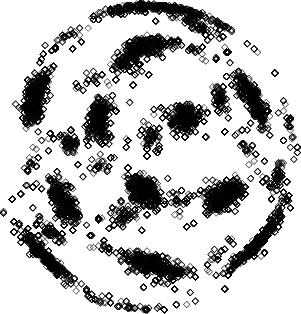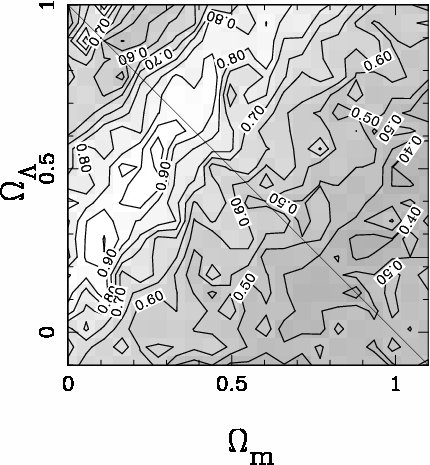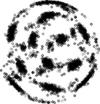You are here: Foswiki>Cosmo Web>WebPreferences>CosmoProjectsBrief (05 Nov 2015, BoudRoukema)Edit Attach
<< Cosmo

 Is the Universe finite or infinite (video)? Scientific models of the Universe are intended to satisfy the Einstein equation, which, roughly speaking, states that curvature = density and that mass density curves space. The models allow many different sorts of spaces, which have the local property called a metric (a sort of rule for locally measuring distances, that determines curvature) and have global properties that define them, such as topology. Global topology can be measured by multiple imaging or by topological acceleration. Together curvature and topology can be described as shape. The metric of the standard Universe model has many parameters such as the Hubble parameter, the baryon density parameter, the baryonic and non-baryonic dark matter density parameter
Is the Universe finite or infinite (video)? Scientific models of the Universe are intended to satisfy the Einstein equation, which, roughly speaking, states that curvature = density and that mass density curves space. The models allow many different sorts of spaces, which have the local property called a metric (a sort of rule for locally measuring distances, that determines curvature) and have global properties that define them, such as topology. Global topology can be measured by multiple imaging or by topological acceleration. Together curvature and topology can be described as shape. The metric of the standard Universe model has many parameters such as the Hubble parameter, the baryon density parameter, the baryonic and non-baryonic dark matter density parameter  , and the dark energy parameter
, and the dark energy parameter  . This standard model is oversimplified: it assumes that for the chosen separation of spacetime into space and time coordinates, the Universe is the same everywhere (homogeneous) in space at a given time coordinate.
. This standard model is oversimplified: it assumes that for the chosen separation of spacetime into space and time coordinates, the Universe is the same everywhere (homogeneous) in space at a given time coordinate.
See also CosmoProjectsOld
Cosmology past and ongoing projects in Toruń - brief summary for main page
include starts hereShape of the Universe

 Is the Universe finite or infinite (video)? Scientific models of the Universe are intended to satisfy the Einstein equation, which, roughly speaking, states that curvature = density and that mass density curves space. The models allow many different sorts of spaces, which have the local property called a metric (a sort of rule for locally measuring distances, that determines curvature) and have global properties that define them, such as topology. Global topology can be measured by multiple imaging or by topological acceleration. Together curvature and topology can be described as shape. The metric of the standard Universe model has many parameters such as the Hubble parameter, the baryon density parameter, the baryonic and non-baryonic dark matter density parameter
Is the Universe finite or infinite (video)? Scientific models of the Universe are intended to satisfy the Einstein equation, which, roughly speaking, states that curvature = density and that mass density curves space. The models allow many different sorts of spaces, which have the local property called a metric (a sort of rule for locally measuring distances, that determines curvature) and have global properties that define them, such as topology. Global topology can be measured by multiple imaging or by topological acceleration. Together curvature and topology can be described as shape. The metric of the standard Universe model has many parameters such as the Hubble parameter, the baryon density parameter, the baryonic and non-baryonic dark matter density parameter  , and the dark energy parameter
, and the dark energy parameter  . This standard model is oversimplified: it assumes that for the chosen separation of spacetime into space and time coordinates, the Universe is the same everywhere (homogeneous) in space at a given time coordinate.
. This standard model is oversimplified: it assumes that for the chosen separation of spacetime into space and time coordinates, the Universe is the same everywhere (homogeneous) in space at a given time coordinate.
Density fluctuations and galaxy formation
But the Universe is not perfectly the same everywhere in space - even when the Universe was just a few hundred thousand years old, some regions were more dense and some were less dense. The more dense regions eventually collapsed under their own weight, via gravity, and formed galaxies, stars, and planets. These fluctuations are not just interesting for galaxy formation, they are also useful for measuring the curvature of space. Density fluctuations on the smaller scales (up to about 1 Mpc, a few million light-years) collapsed gravitationally, forming galaxy clusters and galaxies in which stars and planets formed. Comparing observations of galaxies and galaxy clusters to the cosmic microwave background and separating the two effects was a major theme of the observational aspects of the OCRA program using our 32m radio telescope. Upcoming major survey projects in which Toruń astronomers are involved include the Rubin Observatory (TorunLSST) and 4MOST (Torun4MOST).Cosmological Backreaction
During the epoch of galaxy formation, the Universe switched from nearly homogeneous to very inhomogeneous, so a more accurate metric is needed, according to which mass density is allowed to curve space. With more accurate modelling, "dark energy" is not needed (video), and instead seems to be a misinterpretation of the epoch of structure formation if inhomogeneous curvature is ignored in interpreting observations. The corresponding inhomogeneous metric can be measured using the shift in the baryonic acoustic oscillation (BAO) peak location recently discovered by TCfA cosmologists together with international colleagues.See also CosmoProjectsOld
| I | Attachment | Action | Size | Date | Who | Comment |
|---|---|---|---|---|---|---|
| |
metric_par.jpg | manage | 55 K | 14 Jul 2010 - 00:03 | BoudRoukema | ArXiv:0106135 |
Edit | Attach | Print version | History: r8 < r7 < r6 < r5 | Backlinks | View wiki text | More topic actions
Topic revision: r8 - 05 Nov 2015, BoudRoukema
 Copyright © by the contributing authors. All material on this collaboration platform is the property of the contributing authors.
Copyright © by the contributing authors. All material on this collaboration platform is the property of the contributing authors. Ideas, requests, problems regarding Foswiki? Send feedback


